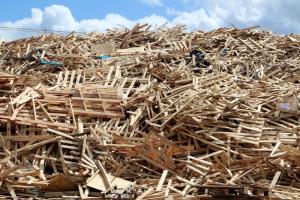Ultimate Guide to Wood Disposal: Recycling, Reusing, Trashing & More

-
Quick Links:
- 1. Introduction
- 2. Understanding Wood Disposal
- 3. Types of Wood and Their Disposal Options
- 4. Recycling Wood
- 5. Reusing Wood
- 6. Trashing Wood
- 7. Special Considerations for Wood Disposal
- 8. Case Studies and Real-World Applications
- 9. Expert Insights on Wood Disposal
- 10. FAQs
- 11. Conclusion
1. Introduction
Wood is a versatile material used in various applications, from construction to furniture making. However, when these wooden items reach the end of their lifespan, knowing how to dispose of them properly is crucial. This guide will explore the different methods of wood disposal, including recycling, reusing, and trashing, along with various best practices to ensure eco-friendly management of wood waste.
2. Understanding Wood Disposal
Wood disposal encompasses all the methods employed to manage wood waste responsibly. Improper disposal can lead to significant environmental issues, such as pollution and habitat destruction. On the other hand, recycling and reusing wood helps conserve resources and reduce landfill waste.
3. Types of Wood and Their Disposal Options
3.1 Softwood
Softwood, derived from coniferous trees, is often used in construction and furniture. Common types include pine, spruce, and fir. Softwood can be recycled or composted.
3.2 Hardwood
Hardwood comes from deciduous trees and is typically denser and more durable. Examples include oak, maple, and cherry. Hardwoods are often reused for furniture or flooring.
3.3 Treated Wood
Treated wood, commonly used for outdoor projects, contains chemicals that can be harmful to the environment. It should be disposed of according to local regulations, often requiring special handling.
4. Recycling Wood
Recycling wood is an environmentally friendly way to manage wood waste. Here’s how to do it:
4.1 Identify Recycling Centers
Find local recycling centers that accept wood. Many communities have specific programs for wood recycling. Check websites like EPA’s recycling page for more information.
4.2 Prepare Wood for Recycling
Before recycling, ensure the wood is clean and free of metal fasteners and paint. Follow local guidelines for preparation.
5. Reusing Wood
Reusing wood not only saves resources but also adds character to your projects. Here are some ideas:
5.1 DIY Projects
Consider creating furniture, garden beds, or decorative items from old wood. Websites like Pinterest offer countless inspiration.
5.2 Community Giveaways
Donate usable wood to community centers, schools, or local artists. This not only helps others but promotes sustainable practices.
6. Trashing Wood
When recycling or reusing isn’t an option, trashing wood is necessary. Here’s how to do it responsibly:
6.1 Check Local Regulations
Some areas have specific rules regarding wood disposal. Contact your local waste management for guidance.
6.2 Schedule Bulk Pick-Up
If you have significant amounts of wood waste, check if your municipality offers bulk pick-up services.
7. Special Considerations for Wood Disposal
7.1 Hazardous Materials
Wood treated with chemicals or containing lead-based paint requires special disposal methods. Always consult with professionals.
7.2 Fire Safety
Improper disposal of wood can lead to fire hazards. Store wood safely until disposal and follow guidelines for burning.
8. Case Studies and Real-World Applications
8.1 Community Recycling Initiatives
Some cities have launched successful wood recycling initiatives, reducing landfill contributions by over 30%. For instance, Vancouver's wood recycling program has become a model for others.
8.2 Successful Reuse Projects
Artisans and DIY enthusiasts have transformed discarded wood into stunning furniture pieces, showcasing the potential of reused materials. The Better Homes and Gardens website features numerous examples.
9. Expert Insights on Wood Disposal
Experts recommend prioritizing recycling and reusing wood over trashing. According to a recent study from NRDC, recycling wood saves significant energy and reduces carbon emissions.
10. FAQs
10.1 What types of wood can be recycled?
Most untreated wood can be recycled, including softwood and hardwood. Check with local centers for specifics.
10.2 How do I prepare wood for recycling?
Remove nails, screws, and any non-wood materials. Ensure the wood is clean and dry.
10.3 Can treated wood be recycled?
Treated wood often cannot be recycled due to harmful chemicals. Consult local guidelines for disposal.
10.4 Where can I donate reusable wood?
Local charities, schools, and community projects are often in need of usable wood. Check local listings.
10.5 What should I do with wood waste from construction?
Contact your contractor for disposal options or check local recycling centers that accept construction waste.
10.6 Is burning wood an option for disposal?
Burning wood can release harmful pollutants. Always follow local regulations and consider safer disposal methods.
10.7 How can I find a wood recycling program near me?
Visit local government websites or use resources like Earth911 to find recycling programs.
10.8 Can I recycle wood furniture?
Yes, wood furniture can often be recycled or donated if it is in good condition.
10.9 What are the environmental benefits of recycling wood?
Recycling wood conserves natural resources, reduces landfill waste, and decreases greenhouse gas emissions.
10.10 How can I find DIY projects for reused wood?
Websites like Pinterest and DIY blogs offer numerous ideas for projects using reused wood.
11. Conclusion
Proper wood disposal is essential for environmental sustainability. By recycling, reusing, or responsibly trashing wood, we can minimize our ecological footprint and contribute to a healthier planet. Whether you’re a DIY enthusiast or simply looking to dispose of old wood, this guide provides the tools and knowledge needed to make informed decisions.
Random Reads
- Uninstall windows 7 guide
- Unlink computer dropbox
- Track your twitch hours
- How to change resolution age of empires 2 hd
- How to make a user account an administrator in windows 8
- How to find matching values in two columns in excel
- How to get cut in pokemon emerald
- How to insert images with html
- How to insert image into shape adobe illustrator
- How to build a city in minecraft